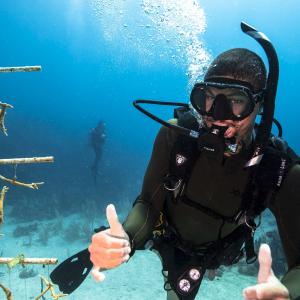Signal to boats that there are divers down below with a locally recognized red flag with a white diagonal stripe or the blue-and-white pennant tail.
Descrição
A dive flag indicates that scuba divers are nearby. In some areas, flying a dive flag while scuba diving is required by law, but in general it’s a good idea for safety reasons. Dive boats fly a flag to let other vessels know that divers are below. You can fly a flag from a dive float you take with you into the water. Visit your PADI Dive Center or Resort to get advice about dive flags and floats.
Standard Features
- Locally recognized – There are two recognized dive flags – a red flag with a white diagonal stripe, and the blue-and-white pennant tail Alpha flag. Know which flag to fly in your local area.
- Staff or pole – If on a float, your flag needs to be high enough on a staff so vessels can see it above waves or chop. A dive flag flying on a boat should be on a pole in a prominent place.
- Float – Needs to be buoyant enough to hold the flag and staff, and stable enough that it doesn’t flip over easily. Floats range from simple inflatable buoys, to torpedo shaped floats for easy towing, to heavy-duty surface support rings.
- For towing a float, you’ll need a line and reel to manage the line.
- To anchor a float, you’ll need an auger, weights or line for tying it to an object (not coral).
Optional Features
- Flag stiffener – A stiffener, often simple wire frames, hold the flag open so it’s clearly visible.
- Inner tube with fabric cover – This style float has good buoyancy and provides a pouch to put accessories in.
How to Choose
- Find out what the locally recognized flag is by visiting your local PADI Dive Shop or Resort. Also, know if local laws stipulate when you must fly a dive flag, how close you must stay to it, and how far vessels must stay away. However, don’t assume boaters will follow the law – always be cautious.
- Consider what float size and style is appropriate for the type of diving you do.
- Think about how you will tow or anchor your float. There are a variety of line and reel options, plus different methods of attaching the line to the float, such as D-rings, handles or loops.
Maintenance
- Rinse your flag, float, line and reel in fresh water after each use and store it in a dry place, out of direct sunlight.
- Check your line regularly for worn spots and replace it as necessary.







 Detritos Marinhos
Detritos Marinhos
 Proteção Contra Tubarões e Raias
Proteção Contra Tubarões e Raias
 Adote o Azul
Adote o Azul














